| Desert Wildflower Report, by Jaimie Hall |
|
April showers bring May flowers -- only
in the case of the desert, winter rains bring flowers from
February through April or May. Unlike wetter areas, each year
in the desert brings the question: Will this be a good year
for wildflowers?
When the desert receives a lot of rain, like this winter,
we expect a banner year for wildflowers. And usually that's
right. This year's bloom is already profuse in the lower elevations
near the Salton Sea and nearby Anza Borrego desert in California.
Blooming brittlebush, with its halo of daisy-like blossoms,
line most desert highways. Many ocotillo plants, which in
dry times look like a clump of tall, dead, black stalks, have
turned green and sport red-flamed tips.
A walk in the desert, especially on a sloping bajada
(an alluvial fan extending from the base of a mountain range
out onto the floodplain), will disclose carpets of tiny white,
yellow and purple flowers mixed in with larger species.
While a few Joshua trees and yucca plants are already blooming,
it is early for most cacti. Cacti blossoms are relatively
independent of rain. However most won't bloom until April
and May, with the tall saguaros blooming from mid-May to Mid-June.
Not all parts of the southwest desert are in bloom.
Not only do wildflowers appear later as elevation increases,
some areas will be left out and have less than a spectacular
year.
HOW DO YOU PREDICT DESERT WILDFLOWER
BLOOMING?
The answer is you can't. A number of factors
determine the bloom and are plant-specific. Many species need
a good soak in autumn. If they miss that rain, few will bloom.
Too much rain, cold or lack of sun can have an effect. In
1995, an excellent year for wildflowers, both Joshua Tree
and Death Valley National Parks were awash with blooms. At
Mojave National Preserve, located in between, hardly any flowers
bloomed. At this writing, it looks like this year could be
a repeat of 1995, with Joshua Tree and Death Valley already
reporting extensive flowering, while Mojave has so far seen
almost none. Some of the variables that affect wildflower
displays in the desert is explained in this
article by Mark Dimmitt.
Fortunately several Web sites and hotlines provide up-to-the-minute
information on where the good blooms are.
REPORTS FROM THE FIELD
Some of my RV friends have sent reports
from where they are. Desert poppies carpet many areas. Desert
sunflowers, desert lily, brown-eyes, dune evening primrose,
desert chicory, Spanish needles, Arizona lupine, desert sand
verbena, desert holly are a few that were seen in the Salton
Sea/Anza Borrego area. In Arizona, from Quartzsite up to Lake
Havasu are nice flowers, and the Ajo loop, north of Organ
Pipe Cactus National Monument has lush blooms of brittlebush,
blue dick and poppies.
WEB SITES & HOTLINES
The wildflower situation can change quickly, so to see the best wildflowers, check with one of these sources before venturing out.
RoadTrip America: Links to some of the most comprehensive wildflower reporting sites for the southwestern United States.
Extraordinary Wildflower Resource - Kris Light is an elementary teacher in Oak Ridge, Tennessee who has built an incredible database that can be used for wildflower identification. Her site has photos of nearly 700 wildflower varieties in Tennessee and hundreds more in the western states. (1/14/07)
Texas
Wildflower Reports
Some hotlines and wildflower information telephone numbers:
Anza Borrego: 760-767-4684
Death Valley: 760-786-2331
Joshua Tree: 760-367-5500
Public lands: 800-354-4595
|
ENJOY THE FLOWERS
Wildflowers can be enjoyed in many ways.
Driving through a wildflower area, taking in the color and
variety and noticing this year's extensive carpet of flowers
gives you the big picture of how many flowers there actually
are. Get out and stroll in the desert to see detail as well
as tiny flowers you would otherwise miss.
Bring along your camera and take panoramic views and
close-ups. A field guide can add a name to the flower. Some
people keep a checklist of species seen, much like a birder's
life list.
Take advantage of activities at state and federal agencies.
At Organ Pipe Cactus National Monument, they are offering
two free van tours daily (at 9:00 a.m. and 2:00 p.m.) with
a limit of ten persons. Reservations are a must. Check with
other national parks for tours or ranger-led wildflower walks.
Remember, look and take all the photos you want, but
don't pick any flowers. Leave them not only for others to
enjoy but to reseed so the next rainy year brings even more
for all of us to enjoy.
Jaimie Hall
3/6/05
(Links updated 12/6/21, RTA)

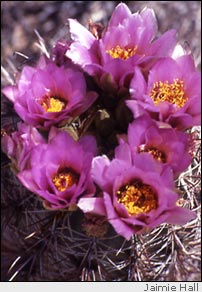
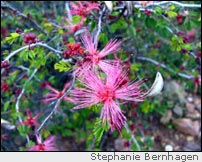
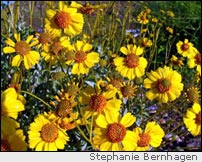
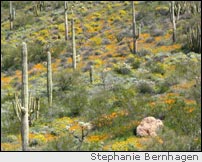
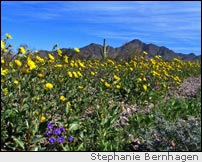
 Alice
Zyetz and Jaimie Hall have
been RVing fulltime with their
husbands for more than ten years
each. Together they have published
two books on the RV Lifestyle:
Alice
Zyetz and Jaimie Hall have
been RVing fulltime with their
husbands for more than ten years
each. Together they have published
two books on the RV Lifestyle: